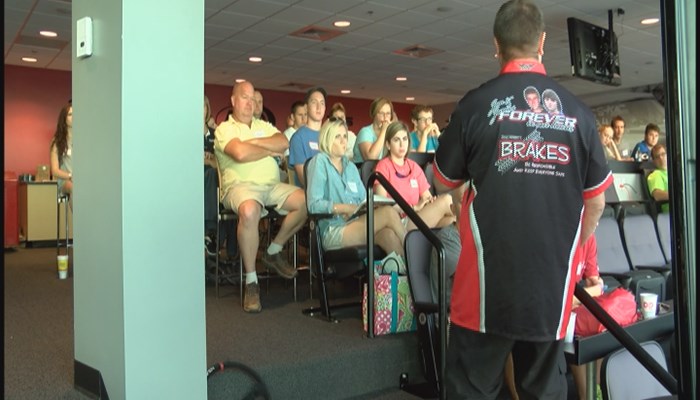CHARLOTTE, NC (WBTV) - The first time I said the name Doug Herbert on WBTV News, it was about the tragic deaths of his two sons, Jon and James, in a horrible crash in January of 2008. The community then watched the former NHRA racing star funnel his sorrow and grief into a mission to save lives.
Doug will tell you, the crash that killed Jon and James, was totally preventable. Officers say Jon was speeding on Jetton Road and lost control of his car, and hit another vehicle head-on. The boys died instantly.
Doug felt, with his knowledge of racing, and vehicle maneuvering, it would be a crime for him not to use his experience to teach kids responsible and defensive driving. First it started with his sons’ friends. It became so popular among teens and their parents, B.R.A.K.E.S., (Be Responsible and Keep Everyone Safe), was created.
 Since its inception, B.R.A.K.E.S. has educated over 17,000 teens and their parents. The mission is to make sure when they walk out of the day-long intensive classroom, and driving exercises, they understand the importance of safe and responsible driving, and have a new understanding of how to achieve that.
Since its inception, B.R.A.K.E.S. has educated over 17,000 teens and their parents. The mission is to make sure when they walk out of the day-long intensive classroom, and driving exercises, they understand the importance of safe and responsible driving, and have a new understanding of how to achieve that.
After talking about the school for so many years, and as the mother of a daughter who will soon get her license, I wanted to see first-hand how the program works. I decided to take the class. I can tell you I walked away from the experience a changed driver.
My lead instructor, Roger Campbell, told students at the beginning of class, “We're going to push you out of your comfort zone and we're going to put you in situations and teach you how to get out of them,” and believe me he did!
Roger, like most of the instructors, has a personal reason for being a part of the B.R.A.K.E.S. mission.
“I've lost an uncle due to a teen driver. Had a young lady drop something in the floor board of her car. And when she reached over to pick it up, the car went with her, (he shows me how she held the steering wheel and leaned over), and she collided with two of my cousins and uncle head-on and killed him. So, I belong to the club that nobody wants to belong to,” Campbell told me, fighting back tears.
Everyone involved in the program is passionate about preventing tragedies like Roger’s family faced. They’ve developed the program and driving courses after studying countless fatal crashes across the country and here in the Carolinas.
There are five courses they put students through, Accident Avoidance, Distraction Exercise, a Wheel Drop-off Recovery Exercise, a Panic Stop Exercise and Car Control and Recovery Exercise.
The latest stats on teen traffic deaths are from 2014. Eighty-six teens died in North Carolina crashes that year. "Lane departure" was cited in every single case. Roger explained that it’s so common because when inexperienced drivers have their wheels go off the road onto the shoulder, their reaction is overcorrection.
Roger first put me through the Wheel Drop-Off exercise. We went through it several times.
As my wheels dropped Roger taught me to, “Take your foot off the gas. Right there did you feel the car just totally change. So now we come back on the road and we are on our way. There is no reason that should be the number one cause of accidents because that is so simple to do,” he explained.
It took me several tries to not touch the brakes, just let off the gas, and slowly make my way back on the road. Then we went through the Accident Avoidance course. Roger had me get up to 35MPH. Ahead was a cable across the road with three lights. Just as I approached the lights, one would turn green. It was my goal to safely maneuver the car into the green lane without touching the brakes.
This simulates what would happen if another car, or a person, or animal, suddenly pulls out in front of your teen driver. For the first three tries, I missed the green lane completely. I wanted to slow down, by tapping the brakes.
“Wrong,” is what Roger told me.
Roger told me why tapping the brakes is a huge problem in this situation.
“No break! You tapped the break. So, what would have happened if there we were in inclement weather? You would have robbed the weight the from the right side of your vehicle and you could actually spin the car out,” Roger said.
I then moved on to the distraction course.
“It takes the average person five seconds to look down at their phone and compute either who is calling or a text. FIVE seconds! That’s enough time to kill someone,” Roger emphasized.
He had me close my eyes driving about 20 MPH and counted then suddenly said, “STOP!” It shook me to my core.
“So what happens is when you were looking down at your phone when your texting and somebody walked out in front of you,” he said. My response, “What would have happened?”
“You would have killed someone,” Roger replied very seriously.
Hydroplaning is something I’ve always feared, and we’ve seen several teen deaths in our area because of we roads, and cars spinning out of control into oncoming traffic. Jay Griffin, who was a Highway Patrolman for decades has seen his share of tragedy on the highway. He was my instructor for this portion of my class.
The official vehicle of the B.R.A.K.E.S. program is Kia. They’ve equipped some of the cars with a special plastic coating they put on deflated tires to help simulate how wheels respond to wet or icy roads.
Jay says this is when the driver needs to use C.P.R., an acronym for the Correcting the vehicle's direction, Pause-let off the gas, and Recover control. It was easier said than done. He says this is where quick thinking is critical.
“You want to steer where you want to go. You want to look where you want to go not there you’re going... but where you want to go,” Jay said.
Jay, like Roger, Doug, the volunteers and those who work with B.R.A.K.E.S. are committed to growing this program so more teens can get these life-saving classes and know how to react when a dangerous situation arises.
The program is a non-profit. There are many corporations that support their efforts. But they ask for help from the communities they serve.
As one parent at my class told me, “We’ve been on the waiting list for a while. But I’m so grateful we were patient. I know this is exactly what my son needs.”
Copyright 2016 WBTV. All rights reserved.
To read the article at WBTV, click here

My oldest daughter went through B.R.A.K.E.S. at 16 (she’s 25 now) and was involved in an accident shortly after. A large pickup towing a landscaping trailer pulled in front of her from an oncoming left turn lane. She had the presence of mind to jam the brakes and control steer into the lighter tr... Click to Read More!
-Derek T
Thank you for this. We absolutely love B.R.A.K.E.S and truly appreciate what you all are doing. Also, a big thank you to every member of your personnel on site. They were wonderful; kind, courteous, helpful, informative, funny and very generous with their time. As soon as we got home we started ... Click to Read More!
-Jamie E